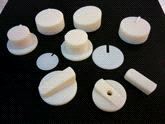Inkjet & Digital Printing
FagorBrandt Reduces Costs and Improves Prototype Quality with Stratasys 3D Printing Technology

Wednesday 10. July 2013 - Leading domestic appliance supplier cuts external costs by over a third, improves precision finishing
Stratasys Ltd. (NASDAQ: SSYS), a leading manufacturer of 3D printers and production systems for prototyping and manufacturing, has announced today that French domestic appliances supplier, FagorBrandt SAS is achieving improved cost-efficiencies and increased finishing precision, thanks to its use of a Stratasys’ Objet-line 3D Printer.
FagorBrandt SAS, headquartered in Rueil Malmaison, France, manufactures a large range of electrical appliances and white goods, and operates an Objet Eden260V 3D Printer to produce prototype models ranging from small items, such as buttons and handles for cookers and dishwashers, to entire front sections of washing machines.
Initially deployed in its design department, FagorBrandt has since extended its use of the 3D printing system to serve the needs of a host of production and engineering projects within the company. Having previously outsourced prototyping, FagorBrandt has, according to Sébastien Aubertin, General Manager Operations Department, witnessed a number of benefits since bringing this activity in-house.
“We are constantly seeking to evolve our ability to produce more complex pieces with moving assemblies, while improving the overall precision and visual aspect of the finished part,” explains Aubertin. “This is vital for our design team who rely on such capabilities to check the accuracy of prototyped pieces, as well as to potentially improve the ergonomic and aesthetic aspects during the design phase.
“I believe that the Objet Eden260V is in a league of its own when it comes to producing smooth and durable models with precise and extremely detailed surface finishing,” he adds. “Indeed, we print at an ultra-thin 16 microns which was only achievable with the Objet-line 3D Printer.”
Overall production costs down by two-thirds
Equally important to Aubertin is the need to keep costs to a minimum and, having been reliant upon external providers for its prototype requirements in the past, FagorBrandt has managed to slash costs since equipping itself with the Objet Eden260V.
“Basically, looking at raw material costs exclusively, the cost to produce a very large prototype part is typically five times less than it was when we were outsourcing, while our overall manufacturing costs are now only a third of what they were previously,” he explains. “When you consider that we’re typically producing up to 500 prototype parts annually, the difference to our bottom line is huge and underscores the cost-efficiency of the in-house 3D printer.”
Several hundred prototype models are developed by Aubertin and his team each year, a large number of which are produced at 1:1 scale. Pieces range from 1 to 24cm in size and comprise parts for three main product groups: ‘Hot goods’, such as cookers, fans and gas hobs; ‘cold goods’, which include fridges and freezers; and ‘wash goods’, namely washing machines and dishwashers.
“When it comes to the complexity and shape of the parts we need to produce, there are no limits to what we can achieve with the Stratasys system,” continues Aubertin. “This is a far cry from the days before 3D printing where we had to use a milling machine which invariably lacked the capability to shape the underside of the prototype piece, for example.”
Further benefits to improve efficiencies and versatility
The Objet Eden260V also provides FagorBrandt with a choice of five main resin types (black, white, transparent, opaque, and rubber-like), with individual technical characteristics offering varying levels of strength and solidity according to requirements.
Another aspect of the 3D printer to score highly with Aubertin is its automated operation which allows up to 72 hours of unattended continuous printing, as well as the print speed.
“This demonstrates the reliability and convenience of the Objet Eden260V as it doesn’t require monitoring by an operator,” he continues.
“At the end of our working day, we can start a job to be automatically built overnight, before returning the next day to find the perfectly-produced part awaiting us. Moreover, we also have the assurance that the part has been produced faster, more cost-effectively and to a higher quality than we were previously able to achieve, demonstrating that the Objet Eden260V 3D Printer doesn’t compromise in one area in favor of another,” concludes Aubertin.
